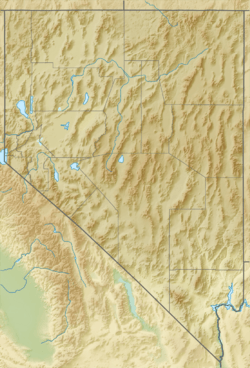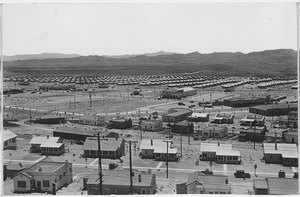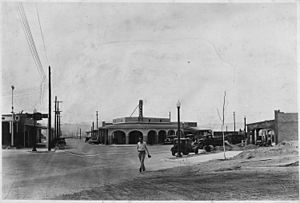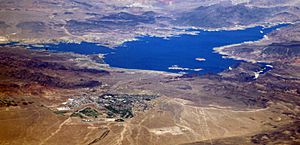Boulder City, Nevada facts for kids
Quick facts for kids
Boulder City, Nevada
|
||
|---|---|---|
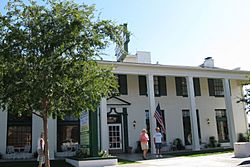
Boulder Dam Hotel built in 1933
|
||
|
||
| Nickname(s):
Home of Hoover Dam
|
||
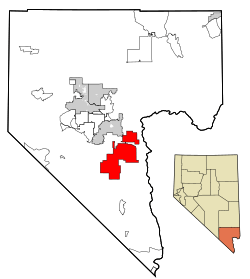
Location within Clark County
|
||
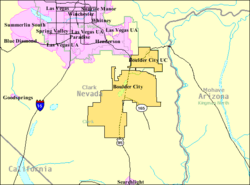
U.S. Census map
|
||
| Country | United States | |
| State | Nevada | |
| County | Clark | |
| Founded | 1931 | |
| Incorporated | January 4, 1960 | |
| Named for | Boulder Canyon | |
| Government | ||
| • Type | Council Manager | |
| Area | ||
| • Total | 208.30 sq mi (539.49 km2) | |
| • Land | 208.26 sq mi (539.40 km2) | |
| • Water | 0.03 sq mi (0.08 km2) | |
| Elevation | 2,510 ft (765 m) | |
| Population
(2020)
|
||
| • Total | 14,885 | |
| • Density | 71.47/sq mi (27.60/km2) | |
| Time zone | UTC−8 (PST) | |
| • Summer (DST) | UTC−7 (PDT) | |
| ZIP codes |
89005–89006
|
|
| Area code(s) | 702 and 725 | |
| FIPS code | 32-06500 | |
| GNIS feature ID | 858617 | |
Boulder City is a city in Clark County, Nevada, United States. It is approximately 26 miles (42 km) southeast of Las Vegas. As of the 2020 census, the population of Boulder City was 14,885. The city took its name from Boulder Canyon. Boulder City is one of only two places in Nevada that prohibits gambling, the other being the town of Panaca.
Contents
History
Beginnings as federal company town
The land upon which Boulder City was founded was a harsh, desert environment. Its sole reason for existence was the need to house workers contracted to build the Hoover Dam on the Colorado River (known commonly as Boulder Dam from 1933 to 1947, when it was officially renamed Hoover Dam by a joint resolution of Congress). Men hoping for work on the dam project had begun settling along the river in tents soon after the precise site for the dam had been chosen by the Bureau of Reclamation in 1930. Their ramshackle edifices were collectively known as "Ragtown".
Boulder City was originally built in 1931 by the Bureau of Reclamation and Six Companies, Inc. as housing for workers who were building the Hoover Dam.
The sheer scale of the dam and duration of the project required the Bureau of Reclamation to consider the construction of a semi-permanent town rather than a temporary arrangement. Boulder City was exceptionally rare as an example of a town fully planned under government supervision. This is unlike 19th century privately funded company town examples found in the United Kingdom, such as Port Sunlight, or in the United States, such as Pullman, Chicago.
Early years: 1930–1934
Boulder City was carefully planned through federal supervision as a model community, with Dutch-born urban architect Saco Rienk de Boer contracted to plan it. DeBoer had been a planner for Denver, Colorado, and was to design many towns and suburbs around the Rocky Mountain region. Because the Hoover Dam project itself represented a focus for optimism for a country suffering from the effects of the Great Depression, the town itself was to be an additional manifestation of this optimism. There was to be an emphasis on a clean-living environment for dam workers. The plan submitted by DeBoer in 1930 was formal and symmetrical with a park and the Bureau of Reclamation building at the termination of the two main axes. The plan was deemed too expensive to carry out in its original form and was modified to allow for more regular block sizes. Nevertheless, its allowance for public space and copious amounts of landscaping earned it the moniker "Nevada's Garden City". The provision of green landscape was another expression of the Bureau of Reclamation's "mission to reclaim and 'green' the American West."
The town was designed to house approximately 5,000 workers. The status of the workers on the Hoover Dam was reflected in their house sizes and locations. The most important employees had their residences on top of the hill nearer the apex. Managers were housed further down the hill, and dwellings for manual laborers were located furthest away from the public buildings and parks. The most radically modified portions of DeBoer's plan were in these lower-class residential blocks, where open space and parks were largely eliminated.
Commercial development was restricted and severely regulated under Sims Ely, the city manager. There were limits to the number of different types of stores allowed in the city, and all who wished to begin a business were screened for character and financial viability. On the other hand, there was no provision for schools in the burgeoning city, probably because the Bureau of Reclamation expected that single male workers would populate the town. The town made do with makeshift schoolrooms until the city won the right for state-funded schools to be established on the federal reservation upon which Boulder City was situated. No hospitals were provided in the city either. Injured workers had to travel 33 miles (53 km) to Las Vegas Hospital, and when a hospital was established in the city, females were not admitted for a number of years.
Similarity to earlier company towns
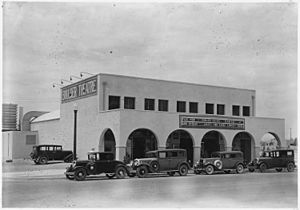
Like early model company town Port Sunlight, the workers of Boulder City were under strict monitoring: alcohol was prohibited in the town until 1969 and gambling has been prohibited since the city's outset. The city was founded during the Prohibition era. Boulder Theatre, established in 1931, meant that workers were not obliged to travel to Las Vegas for amusements. Such measures were common for company towns dating back to the 19th century, since sober workers surrounded by their own gardens and provided with appropriate entertainment would be more productive during their working days.
In the case of Boulder City, the prohibition of alcohol and gambling was at least partly due to the proximity of Las Vegas, which had a notoriously rowdy vice district. Visitors to Boulder City were admitted by permit, and by 1932, there was a gatehouse through which all visitors had to pass.
Trendsetter for decentralization
While the establishment of Boulder City occurred while Las Vegas was modest in size with approximately 5,000 inhabitants, it was effectively the beginning of the fragmentation of cities in the region of Clark County. This move to disperse to multiple centers predated the decentralization movement of the 1970s. The nearby city of Henderson, founded in 1943 and based around the magnesium industry, was another early example of decentralization before Clark County had a significant population: "...the region began to decentralize and regroup as a multi-centered area early in its history." The independent governments of Henderson, North Las Vegas, Las Vegas, and Boulder City have perpetuated the fragmented nature of the region, giving each city its individual character, as well as generally stymieing the outward growth of these cities.
1960s onwards
The government did not relinquish control of Boulder City until 1959, when the town was incorporated. Boulder City's incorporation ceremony took place on January 4, 1960. The city council selected pharmacist Robert N. Broadbent as the city's first mayor.
The city charter, approved by the residents, prohibited gambling within the city limits. This provision still exists, making Boulder City one of only two locations in Nevada where gambling is illegal (the other is the town of Panaca). The Hoover Dam Lodge hotel-casino permits gambling and has a Boulder City mailing address, but it is located on a parcel of private land within the boundaries of the Lake Mead National Recreation Area and thus not within city limits.
Another casino on the other end of town is the Railroad Pass Hotel and Casino, which has a Boulder City telephone prefix, but is within the boundary of the neighboring city of Henderson.
Alcohol sales were first permitted in 1969.
On August 9, 2018, the Boulder City Bypass opened to the public as part of the Interstate 11 project. The bypass is still within Boulder City's city limit, but bypasses the populated area. Initially, businesses and the populace were concerned that the bypass would have a negative effect on the local economy, though it seems that the opposite was true for some businesses.
Geography
According to the United States Census Bureau, the city has a total area of 208.6 square miles (540.2 km2), of which 0.039 square miles (0.1 km2), or 0.02%, is water. This ranks Boulder City as the largest city in Nevada by land area and 35th in the country, but gives it a low density rate of only about 72 people per square mile.
Boulder City maintains strict controls on growth, limited to 120 single- or multi-family residential building permits for new construction per year. Hotels are also restricted to no more than 35 rooms. These restrictions are defined in the city code of Boulder City.
Climate
According to the Köppen climate classification system, Boulder City has a hot desert climate (Köppen type BWh)
| Climate data for Boulder City | |||||||||||||
|---|---|---|---|---|---|---|---|---|---|---|---|---|---|
| Month | Jan | Feb | Mar | Apr | May | Jun | Jul | Aug | Sep | Oct | Nov | Dec | Year |
| Record high °F (°C) | 75 (24) |
86 (30) |
91 (33) |
97 (36) |
111 (44) |
114 (46) |
117 (47) |
112 (44) |
110 (43) |
100 (38) |
90 (32) |
78 (26) |
117 (47) |
| Mean daily maximum °F (°C) | 54.5 (12.5) |
59.9 (15.5) |
67.6 (19.8) |
76.4 (24.7) |
85.9 (29.9) |
95.9 (35.5) |
101.6 (38.7) |
99.5 (37.5) |
92.6 (33.7) |
79.8 (26.6) |
64.5 (18.1) |
55.6 (13.1) |
77.8 (25.4) |
| Mean daily minimum °F (°C) | 38.6 (3.7) |
42.3 (5.7) |
47 (8) |
53.8 (12.1) |
61.9 (16.6) |
70.4 (21.3) |
76.7 (24.8) |
75.4 (24.1) |
69 (21) |
58.5 (14.7) |
46.6 (8.1) |
39.7 (4.3) |
56.7 (13.7) |
| Record low °F (°C) | 11 (−12) |
12 (−11) |
25 (−4) |
31 (−1) |
37 (3) |
41 (5) |
56 (13) |
59 (15) |
43 (6) |
30 (−1) |
26 (−3) |
9 (−13) |
9 (−13) |
| Average precipitation inches (mm) | 0.66 (17) |
0.64 (16) |
0.66 (17) |
0.34 (8.6) |
0.18 (4.6) |
0.09 (2.3) |
0.49 (12) |
0.71 (18) |
0.51 (13) |
0.32 (8.1) |
0.43 (11) |
0.51 (13) |
5.55 (141) |
| Average snowfall inches (cm) | 0.6 (1.5) |
0.1 (0.25) |
0.1 (0.25) |
0 (0) |
0 (0) |
0 (0) |
0 (0) |
0 (0) |
0 (0) |
0 (0) |
0 (0) |
0.1 (0.25) |
1 (2.5) |
| Average precipitation days | 3 | 4 | 4 | 2 | 1 | 1 | 3 | 3 | 2 | 2 | 2 | 3 | 30 |
| Source: WRCC | |||||||||||||
Demographics
| Historical population | |||
|---|---|---|---|
| Census | Pop. | %± | |
| 1950 | 3,903 | — | |
| 1960 | 4,059 | 4.0% | |
| 1970 | 5,223 | 28.7% | |
| 1980 | 9,590 | 83.6% | |
| 1990 | 12,567 | 31.0% | |
| 2000 | 14,966 | 19.1% | |
| 2010 | 15,023 | 0.4% | |
| 2020 | 14,885 | −0.9% | |
| U.S. Decennial Census | |||
As of the census of 2000, there were 14,966 people, 6,385 households, and 4,277 families residing in the city. The population density was 73.9 inhabitants per square mile (28.5/km2). There were 6,979 housing units at an average density of 34.4 per square mile (13.3/km2). The racial makeup of the city was 94.5% White, 0.7% African American, 0.7% Native American, 0.7% Asian, 0.2% Pacific Islander, 1.3% from other races, and 1.9% from two or more races. Hispanic or Latino of any race were 4.3% of the population.
There were 6,385 households, out of which 23.6% had children under the age of 18 living with them, 55.8% were married couples living together, 7.4% had a female householder with no husband present, and 33.0% were non-families. Of all households 27.6% were made up of individuals, and 13.1% had someone living alone who was 65 years of age or older. The average household size was 2.30 and the average family size was 2.79.
In the city, the population was spread out, with 20.4% under the age of 18, 5.3% from 18 to 24, 21.3% from 25 to 44, 29.3% from 45 to 64, and 23.7% who were 65 years of age or older. The median age was 47 years. For every 100 females, there were 97.8 males. For every 100 females age 18 and over, there were 96.0 males.
The median income for a household in the city was $50,523, and the median income for a family was $60,641. Males had a median income of $42,041 versus $30,385 for females. The per capita income for the city was $29,770. About 4.7% of families and 6.7% of the population were below the poverty line, including 9.4% of those under age 18 and 5.3% of those age 65 or over.
2020 census
As of the census of 2020, there were 14,885 people, and 6,156 households residing in the city. The population density was 71.5 people per square mile. The racial makeup of the city was 88.9% White, 1.1% African American, 0.4% Native American, 1.4% Asian, 0.0% Pacific Islander, and 6.8% from two or more races. Hispanic or Latino of any race were 8.4% of the population.
There were 6,125 households, out of which 6.3% spoke a language other than English, and 85.8% of residents were living in the same house a year ago. The average household size was 2.37 people.
In Boulder City, 18.1% of people were under 18, and 4.5% of people were under 5. 29% of people were older than 65. 50.6% of the population was female, with 49.4% being male.
The median income for a household in the city was $69,746, but the per capita income was $41,421. 11.4% of people were in poverty.
Economy
Hoover Dam in marketing
The proximity of Hoover Dam to Boulder City is reflected in many of the businesses in the historic Downtown district, which is home to the Boulder Dam Hotel, home of the Boulder City/Hoover Dam Museum. (The hotel is named after the dam's former name.)
..... The Boulder City Chamber of Commerce has used the slogan "Best City By A Dam Site" in promotions, and the city hosts an annual festival of short subject films dubbed "The Dam Short Film Festival". Boulder City also hosts a number of Hoover Dam related events such as "That Dam Guy Stole My Dam Car" car race and "Get Off My Dam Lawn" gardening festival.
Points of interest
- Alan Bible Botanical Garden
- Bootleg Canyon Mountain Bike Park
- Hoover Dam Museum
- Hoover Dam
- Lake Mead
- Nevada Southern Railroad Museum
- Boulder City Conservation Easement
Sports
In 1975, a team from Boulder City won the Almost Anything Goes! national championship, broadcast on ABC television. The following year, they won a "Supergames" playoff against the 1976 champions from Chambersburg, Pennsylvania, and a celebrity all-star team. However, the show was cancelled soon after.
Parks and recreation

Boulder City has two municipal golf courses (Boulder City Municipal Golf Course and Boulder Creek Golf Course), one private golf course, a city pool, racquetball complex, lit tennis courts, athletic fields, BMX bicycle track, ample mountain hiking trails, and is only a few miles away from Lake Mead. Nevada's first airport, Boulder City Municipal Airport, is still in operation today, accommodating private planes, skydiving trips, and scenic aerial tours of Hoover Dam and the Grand Canyon.
Education
Boulder City's four public schools fall under the jurisdiction of the Clark County School District. Boulder City High School serves grades nine through twelve and has an average enrollment of 700–750 students. It was one of fourteen Clark County schools to become a five-star school in 2012. Elton & Madeline Garrett Junior High School serves grades six through eight. Martha P. King Elementary School serves grades three through five. Andrew J. Mitchell Elementary School serves grades K through two. Boulder City is also home of one non-profit private religious elementary school, Grace Christian Academy, which offers a Christian education for grades kindergarten through five. The school is part of Grace Community Church.
Boulder City also houses a small satellite campus of the College of Southern Nevada.
Boulder City has a public library, the Boulder City Library. The Boulder City Library featured in the plot of the Oscar-winning 2016 film La La Land as the landmark across the street from the childhood home of the film's fictional heroine, aspiring actress Mia Dolan. However, La La Land's scenes of Mia's neighborhood in Boulder City (including the library) were actually filmed in Santa Clarita, CA.
Media
Stephens Media publishes the Boulder City Review. Until it ceased publication in 2009, the Boulder City News was the local newspaper.
Infrastructure
The northern Eldorado Valley contains Boulder City's "Eldorado Energy Zone" which is home to the 480 MW El Dorado natural gas power plant, as well as several other projects. In 2019, the city announced plans to lease up to 1,100 acres (450 ha) in Black Hills South as a utility-scale solar facility. The city hopes to generate $1.65 million annually from the lease.
- Boulder City Hospital
- Boulder Dam Hotel
- Copper Mountain Solar Facility
Transportation
Highways in Boulder City are listed here.
 Interstate 11
Interstate 11 U.S. Route 93
U.S. Route 93
 U.S. Route 93 Business (Boulder City, Nevada)
U.S. Route 93 Business (Boulder City, Nevada) U.S. Route 95
U.S. Route 95 State Route 165
State Route 165 State Route 173
State Route 173
Notable people
- Desi Arnaz, Jr. (born 1953), actor-musician who, with his wife, Amy, owns the Boulder Theatre, a former cinema converted into a live theatre, which is home to the Boulder City Ballet Company (originally from Los Angeles).
- Paul C. Fisher (1913–2006), inventor, politician and founder of the Fisher Spacepen Co., located in Boulder City (originally from Lebanon, Kansas).
- Terry Goodkind (1948–2020), writer known for the epic fantasy series The Sword of Truth as well as the contemporary suspense novel The Law of Nines (2009), which has ties to his fantasy series (originally from Omaha, Nebraska).
See also
 In Spanish: Boulder City (Nevada) para niños
In Spanish: Boulder City (Nevada) para niños



